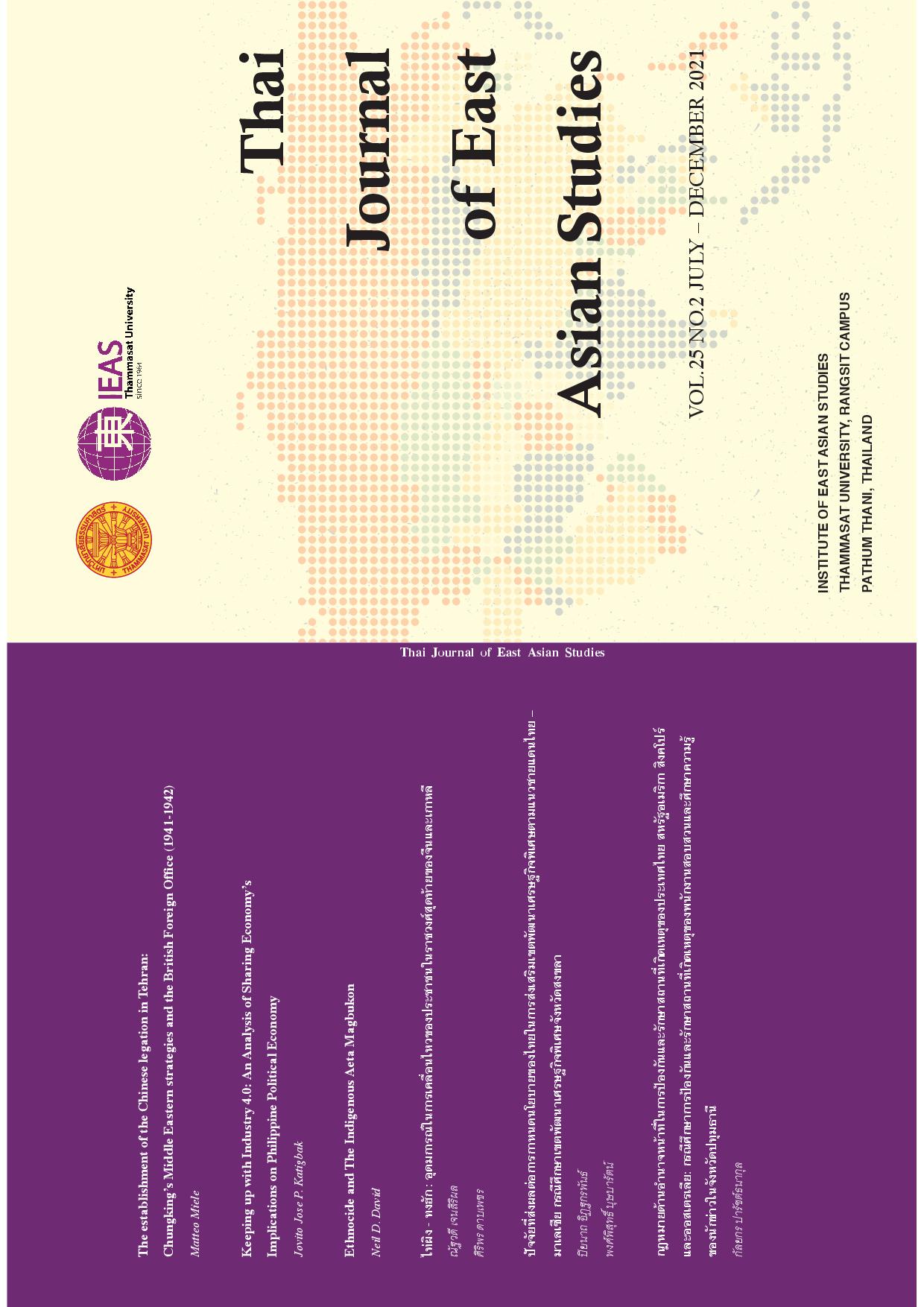Ethnocide and The Indigenous Aeta Magbukon
Keywords:
Aeta Magbukon, ethnocide, ethnicity, indigenous people, ethnographyAbstract
This ethnographic study aimed to assess the facts and reasons for ethnocide on the part of the participants. It results from but is not limited to acculturation, assimilation, development, colonial mentality, and geography. The study found that while a significant number of participants have a good understanding of their material culture, their perception of how it is practiced is concerning. Their knowledge of their intangible culture is still sufficient for their continued creativity and existence, and such practice must be considered. Overall, the participants' practice is torn between being kept and discarded. The participant's perception of what causes ethnocide is dominated by a preference for a modern lifestyle, inability to speak the native dialect, non-speaking of the native dialect, and ethnic culture is not taught in-home or school. The majority of participants believe that their ethnic culture should be modified, preserved, or not practiced, particularly in terms of beliefs and practices. Most of the participants strongly agree on the importance of preserving ethnic culture for identity and solidarity.
Downloads
References
Baker, C. (2007). Aboriginal Student Achievement and Positive Learning Outcomes in Canadian Schools: Promising Practices. In Saskatchewan Ministry of Education (Ed.), Diverse Educational Systems and Learning. University of Saskatchewan.
Basco, D.Y., Bay-os, T., Norma, W. D., Mary, T., Angela, B., Clemencia, D. L., Rosaline B., & Angelina, B. (2005). Socio-Cultural and Political Significance of Ethnocide to College Students of Baguio City. https://citeseerx.ist.psu.edu/viewdoc/download
Bellier, I. (2005). The declaration of the rights of indigenous peoples and the world indigenous movement. Griffith Law Review, 14(2), 227-246 https://doi.org/10.1080/10383441.2005.10854558
Charters, C. & Stavenhagen, R. (2009). Making the Declaration Work: The United Nations Declaration on the Rights of Indigenous Peoples. Eks-Skolens.
Commission on Higher Education. (1994). Republic Act 7722. https://www.officialgazette.gov.ph/downloads/1994/05may/19940518-RA-07722-FVR.pdf
Council of Ministers of Education. (2010). Strengthening Aboriginal Success: Moving Toward Learn Canada 2020. Council of Ministers of Education. https://www.cmec.ca/Publications/Lists/Publications/Attachments/221/aboriginal_summit_report.
Curry, L. A., Nembhard, I. M., & Bradley, E.H. (2009). Qualitative and mixed methods provide unique contributions to outcomes research. Circulation, 119(10), 1442-1452.
Czermak, K., Delanghe, P., & Wei, W. (2003). Preserving intangible cultural heritage in Indonesia: A pilot project on oral tradition and language preservation. https://citeseerx.ist.psu.edu/viewdoc/download?doi=10.1.1.483.191&rep=rep1&type=pdf
David, N. (2014). The Magbukon Literary Arts among the Aetas of Bataan, Philippines. IAMURE International Journal of Multidisciplinary Research, 11(1). https://doi.org/10.7718/iamure.v11i1.906
Dimitropoulos, K., Manitsaris, S., Tsalakanidou, F., Denby, B., Buchman, L., Dupont, S., & Grammalidis, N. (2018). A Multimodal Approach for the Safeguarding and Transmission of Intangible Cultural Heritage: The Case of i-Treasures. IEE Intelligent Systems, 33(6), 3-16. https://doi.org/10.1109/MIS.2018.111144858
Genzuk, M. (2003). A Synthesis of Ethnographic Research. Occasional Paper Series. Center for Multilingual, Multi-Cultural Research. Rossier School of Education. University of Southern California.
Gilbert, J. (2012). Indigenous Rights in the Making: The United Nations Declaration on the Rights of Indigenous Peoples. International Journal on Minority and Group Rights, 14(2), 207-230. https://doi.org/10.1163/138548707x208818.
Guest, G., Namey, E., & Mitchell, M. (2013). Collecting Qualitative Data: A field manual for applied research. Sage.
Grattan, D. (2006). Intangible Heritage and Conservation - Balancing Usage and Preservation. CCI Newsletter, 37, 9-10.
Hammersley, M, & Atkinson, P. (2007). Ethnography principles in practice (3rd edition). Routledge.
Headland, T. N. (2019). Thirty endangered languages in the Philippines. Work Papers of the Summer Institute of Linguistics, University of North Dakota Session, 47(1). https://doi.org/10.31356/silwp.vol47.01
Jocson, A.N. (2013). Indigenous people's education curriculum in the Philippines. www.slideshare.net/.../indigenous-peoples- education-curriculum-of-the-Kawulich, B. (2005). Participant Observation as a Data Collection Method. Forum Qualitative Sozialforschung Social Research, 6(2), Art. 43. http://nbn-resolving.de/urn: NBN: de: 0114-fqs0502430
Kitzinger, J. (1995). Qualitative Research: Introducing focus groups. BMJ, 311, 299-302. https://doi.org/10.1136/bmj.311.7000.299
Matsuura, K. (2005). UNESCO Universal Declaration on Cultural Diversity. Diogenes, 52(1), 141-145. https://doi.org/10.1177/0392192105050618
National Committees for Research Ethics in Norway. (2006). Guidelines for Research Ethics in the Social Sciences, Law and the Humanities. https://graduateschool.nd.edu/assets/21765/guidelinesresearchethicsinthesocialsciene slawhumanities.pdf
Nickel, J. (1994). Ethnocide and Indigenous People. Journal of Social Philosophy, 25, 84-98. https://www.researchgate.net/publication/327655192_Ethnocide_and_Indigenous_Peoples_Journal_of_Social_Philosophy_25_1994_84-98
Pruim, S. (2014). Ethnocide and Indigenous Peoples: Article 8 of the Declaration on the R i g h t s o f Indigenous Peoples. Adel. L. Rev., 35(49), 269.
Rimando, A. J. (2013). DepEd adopts an education framework for the Philippines' Indigenous Peoples. The Philippine Star. https://www.pressreader.com/philippines/the-philippine-star/
Salang, B. Q. (2012). The Role of Women in the Yakan Weaving the Maintenance and in the Preservation of Cultural Heritage. IAMURE International Journal of Social Sciences, 4(1). https://doi.org/10.7718/ijss.v4i1.437
Scarpaci, J. L. (2016). Introductory Essay Material Culture and the Meaning of Objects. Material Culture 48(1), 1-9.
Trimmer, S. M. & Wood, F. (2016). Ethnographic methods for process evaluations of complex health behavior interventions. Trials, 17, 1-11. https://doi.org/10.1186/s13063-016-1340-2
UN General Assembly. (2007). Declaration on the Rights of Indigenous Peoples. https://www.un.org/development/desa/indigenouspeoples/wpcontent/uploads/sites/19/2018/11/UNDRIP_E_web.pdf
UNESCO. (2017). Tangible Cultural Heritage. http://www.unesco.org/new/en/cairo/culture/tangiblecultural-heritage/
UNESCO. (2003). Tangible and Intangible Cultural Heritage. https://resources.riches-project.eu/glossary/tangible-and-culturalheritageheritage/project.eu/glossary/tangible-and-intangiblecultural-heritage/
UNESCO. (2009). Convention for the Safeguarding of the Intangible Cultural Heritage. https://ich.unesco.org/doc/src/ITH-09-4.COM-CONF.209-Decisions-EN.doc
UNITED NATIONS. (2016). Protecting Languages, Preserving Cultures. https://www.un.org/en/desa/protecting-languages-preserving-cultures-0
UNESCO/UMAS. (2001). What is Intangible Cultural Heritage? First Proclamation of Masterpieces of the Oral and Intangible Heritage of Humanity. http://www.unesco.org/archives
Valdez, A. V. (2013). Ethnoscience among Select Indigenous Groups in Mindanao. IAMURE International Journal of Social Sciences, 6(1). https://doi.org/10.7718/ijss.v6i1.513
Vecaldo, R.T. (2013). Dynamics of Urok Practice: Metaphor of Bago's Mutuality and Solidarity. IAMURE International Journal of Social Sciences, 6(1). https://ejournals.ph/article.php?id=2271
Woodbury, A. (2009). What is an Endangered Language?. Linguistic Society of America, https://www.linguisticsociety.org.
Zimmerman, M. (2016). The Importance of Preserving and Promoting Languages: A Liberal Arts Perspective. HuffPost. https://www.huffpost.com/entry/the-importance-of preserv_b_12088728
Zhang, Y., & Wildermuth, B. (2009). Unstructured Interview. In B. Wildermuth (Ed.), Applications of Social Research Methods to Questions in Information and Library Science (pp. 222-231). Libraries Unlimited.
Downloads
Published
How to Cite
Issue
Section
License
Copyright (c) 2021 Thai Journal of East Asian Studies

This work is licensed under a Creative Commons Attribution-NonCommercial-NoDerivatives 4.0 International License.



